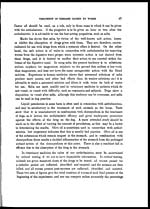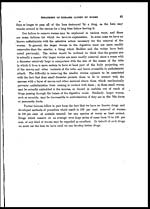Medicine - Veterinary > Veterinary colleges and laboratories > Indian journal of veterinary science and animal husbandry > Volume 1, 1931 > Part I (March 1931) > Use of drugs in the treatment of diseases caused by worms
(78) Page 44
Download files
Individual page:
Thumbnail gallery: Grid view | List view

44 THE INDIAN JOURNAL OF VETERINARY SCIENCE AND ANIMAL HUSBANDRY [ I, I
of efficacy of the drug, provided a sufficiently large number of experiment animals
is used.
This method of ascertaining efficacy by critical testing has its limitations.
Worms destroyed in the stomach usually undergo complete digestion, or are
partially digested before passing to the intestine. Further, this method cannot be
depended on to ascertain contraindications for the use of anthelmintics owing to
the limitation in the number of animals which can be used. One may ascertain
much as to toxicity of the drug by using high doses, and one can find some test
animals with such general contraindications as febrile conditions, extreme youth,
etc., but it requires the larger test of clinical experience in various places and at
various times to ascertain possible contraindications of all sorts. Here is a field
of observation to which insufficient attention is paid by the veterinarian in practice.
He keeps too few clinical records, and spends too little time in their analysis, to
furnish the information he might furnish along this line. For this reason the
pharmocologist would have to be depended on for the most part, to ascertain the
effect of a drug on an animal in order to give us a general basis on which to predi-
cate contraindications.
The alternative to critical testing is investigation by the egg-count method,
and this method has decided limitations. Egg-counts do not show male worms,
larval or immature worms, sterile females, or females, in which egg production has
been inhibited temporarily by drug action. Their value is also limited by our limited
knowledge or ignorance of egg ratios for many worms, our inability to distinguish
the eggs of many of the various worm species, variations in egg production and in
character and amount of the fæces, and errors in technic.
In clinical experience combined with laboratory procedures for checking
anthelmintic treatments there are certain things which may be kept in mind in
connection with the appearance of eggs in the fæces after treatment. These eggs
may indicate what they seem to indicate—the complete or partial failure of the
anthelmintic. On the other hand, they may indicate the appearance in the digestive
tract of worms which had been wandering through the tissues or developing in cysts
at the time the treatment was given, especially if the faces are examined several
days after treatment. They may also indicate that worms were inaccessible at the
time of treatment, as would be the case with egg-producing female ascarids in
the bile ducts.
In judging the value of an anthelmintic, one must allow time for the passage
of the dead worms. Dog ascarids may pass for seven days although over 80 per
cent. come away the first 24 hours. An examination of the fæces of dogs for four
days will account for 98 per cent. of the worms passed. Horses may require 17
Set display mode to: Large image | Zoom image | Transcription
Images and transcriptions on this page, including medium image downloads, may be used under the Creative Commons Attribution 4.0 International Licence unless otherwise stated. ![]()
| Permanent URL | https://digital.nls.uk/75226028 |
|---|
| Description | Covers articles from 1931. |
|---|




